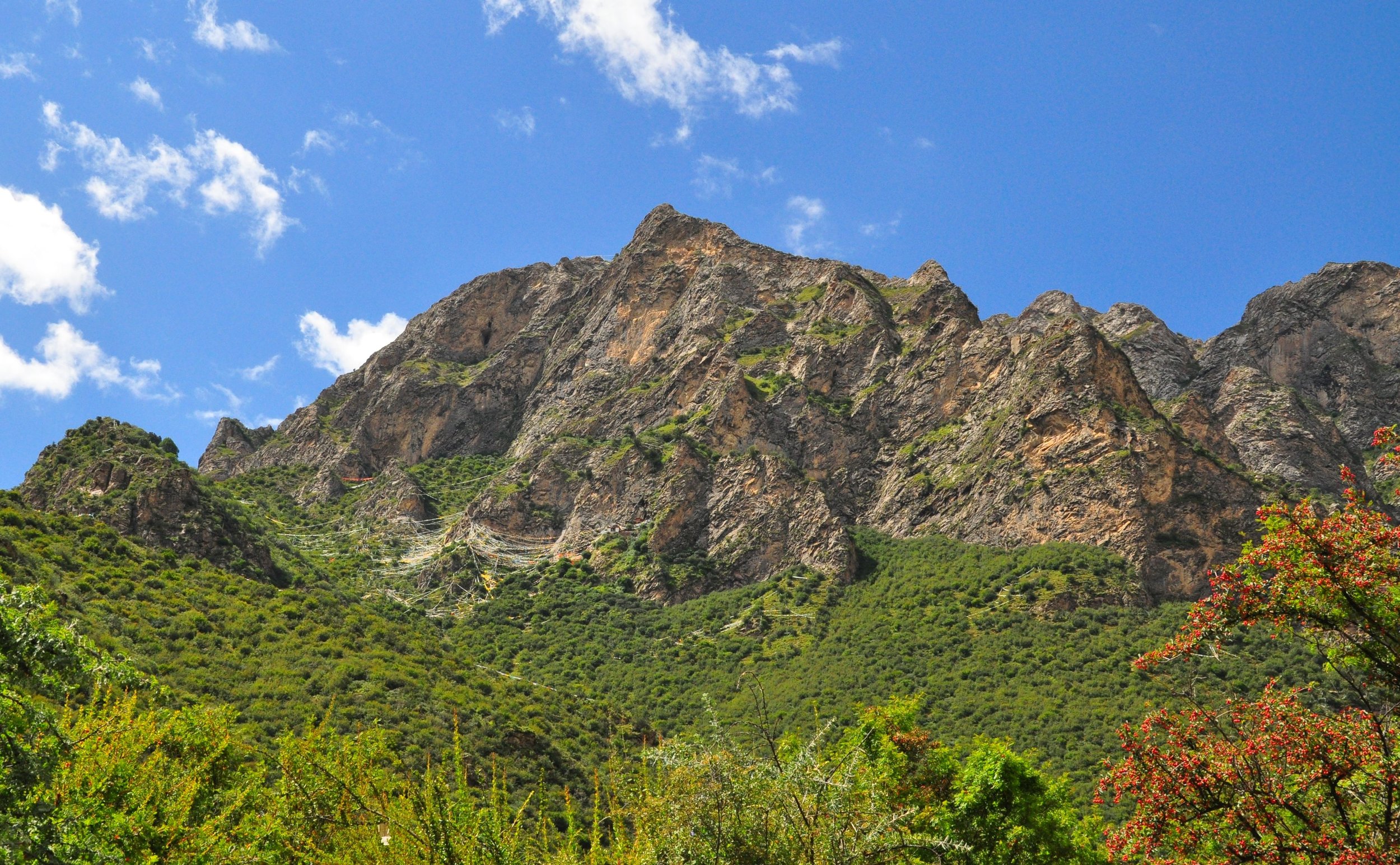Drak Yangdzong
Awakened Body
“The awakened body of blazing vajra-wisdom, destroyer of confused, dualistic minds,
Instantly appears, peaceful and smiling, granting relief to the ocean of beings—
Glorious heruka, Vanquisher of Time, your splendor is like the morning sun rising,
A pleasure grove, replete with all inner and outer excellence, to delight the vidyadharas.
”
at a glance
Drak Yangdzong, The Clifftop Fortress, was blessed by the Mahaguru’s practice of Yamantaka, the wrathful aspect of Manjushri, thus rendering it identical to the awakened body of the buddhas. After staying here in retreat, the Mahaguru hid several terma treasures for later fortunate disciples.
the story
Yamantaka is the wrathful form of Manjushri, the actual body- essence of all the buddhas. Being a form of Manjushri, the embodiment of wisdom, Yamantaka is known for greatly accelerating a practitioner’s wisdom and intelligence. The very name Yamantaka—“Slayer of Yama (the Lord of Death)”— suggests how the practice is also a powerful means for extending the practitioner’s life.
Guru Rinpoche initially received the Yamataka teachings from Manjushrimitra upon Mount Malaya and then practiced them in retreat until receiving a direct vision of Yamantaka. Once the Mahaguru reached Tibet, he chose the caves of Drak Yangdzong as the sacred site where Yamantaka’s blessings would especially reside. By one-pointedly practicing Yamantaka there himself, he not only introduced this practice tradition to Tibet, but also blessed the site as being identical to his own awakened body. Later, when he gave the Kagyé empowerments at Samyé Chimpu, these Yamantaka teachings were entrusted to Nupchen Sangyé Yeshé, who practiced them at Drak Yangdzong at the Mahaguru’s command.
It was at this time that Guru Rinpoche and Khandro Yeshé Tsogyal concealed many terma treasures in the caves and surrounding area. Specifically, the Mahaguru hid a longevity vase bearing extraordinary instructions, and a skull cup, at Drak Yangdzong’s Crystal Cave.
There were many who eventually followed the Mahaguru’s example and went into retreat at Drak Yangdzong, with fifty-five of them reaching especially profound accomplishment, becoming collectively known as the Fifty-Five Yogis of Yangdzong.
Words from the Masters
Changdak Tashi Topgyal’s Prayer to the King and Twenty-Five Disciples
How to get there
Drak Yangdzong (29°24'07.4"N 91°14'17.4"E) can be visited in a single day’s trip from Lhasa. However, we recommend you to stay overnight at Ngadrak village or Chusi Nunnery upon your return from Drak Yangdzong. Busses leave from Lhasa’s Barkhor Sqaure to Dranang and stop a few kilometers before at the Yarlung Tsangpo. From there trucks will be available to Ngadrak village (29°22'4"N 91°16'24"E). If enough pilgrims are present, the trucks may bring you to Chusi Nunnery (29°23'47.3"N 91°14'58.1"E). If not, they will stop at Ngadrak village from which you can try to take another vehicle to Chusi Nunnery.
While at the main site
Ladder leading into the main cave
A steep slope, named Shinje Rolpai Potang, The Palace of the Dancing Lord of Death, climbs from behind the Chusi Nunnery to the high peaks above. Several hundred meters up the slope, you will see a façade that has been painted white. It marks the entrance to the main cave, with walls 15 meters high and 10 meters wide. To the left of the entrance is a mani wall covered in naturally-arisen syllables.
There are three consecutive caves. The first cave, Shinje Drupne Zho, is a vast cavern that houses a bronze semi-wrathful statue of Guru Rinpoche together with statues of his two consorts Lhacham Mandarava and Khandro Yeshé Tsogyal. Outside and to the left is the second cave, Shinjé Rolpé Drupné, accessed by a ladder leading through a narrow tunnel. In this cave, you can see a large and clearly visible naturally-arisen Hum syllable and a phurba. It is also within this cave where several terma discoveries have been made. Shinje Rolpei Drupne contain many stalactites in various shapes and lengths, many rocks and crystalline formations. The most prominent of these is located in the center of the lower space. A clear crystalline formation the size of a cricket ball, it is known as the ‘heart of the cave.’ Rock formations representing different deities and small crystalline ringsel decorate the interior of this large cave.
From this section of Shinjé Rolpé Drupné, descending to the base of the ladder, there is another crevice to squeeze through. Here is the cave of Yeshe Tsyogal called the Khandro Sangphuk or Khandro’s Secret Cave. There is a hole in the cave floor that is said to be where Yeshe Tsogyel got her water while in retreat. Many pilgrims report a white liquid dripping from a rock inside. Guru Rinpoche’s retreat cave, called Guru Sangwa Drupuk, is located some way above this cave, however it is very difficult to reach.
Further west is the third cave Jago Rangjung Drupuk, also called ‘Nego Sarpa’. This cave was revealed by the 4th Dorjé Drak Rikdzin, Pema Trinlé (1641–1717) as a beyul, ‘a hidden land’. The 8th Dorjé Drak Rigdzin, Pema Wangyal (1848–1880) performed a Yamantaka practice here credited with preventing an incoming Singbu army from invading Tibet. Higher up on the western hill is Shitavana Charnel Ground. And, outside the main caves, there is a narrow trail descending to the right which leads to the smaller and less-visited Ekajati Cave. Inside are various naturally-arisen syllables.



